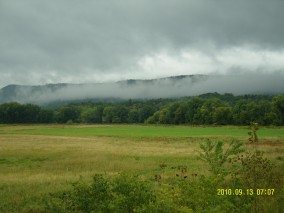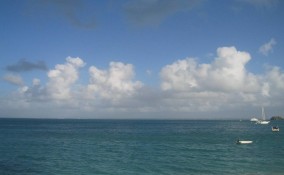The Earth’s Water Cycle
Alan K. Betts (akbetts@aol.com)
May 20, 2010
Abstract: A review of some key aspects of the Earth’s Water Cycle
The Earth’s water cycle is central not only to the earth’s climate, but to all aspects of life on this planet. It is one key component that humanity must understand and adapt to. In the physical climate system, we have discussed two key roles in the energy balance of the earth. The high albedo of snow, ice and clouds is important in reflecting sunlight and cooling the planet. Water vapor is a powerful greenhouse gas, which reduces the cooling of the earth to space in the infrared; and water vapor in the atmosphere increases very rapidly with temperature. The greenhouse gases keep the global mean surface temperature well above freezing. The years 1961-1990 are often taken as a reference baseline, when the global mean surface temperature was 14◦C (57◦F). Without the greenhouse gases, the Earth would all be frozen with a temperature around -18◦C (0◦F).
Every degree higher relative to freezing reduces the ice which reflects sunlight and increases the atmospheric water vapor, a greenhouse gas. Both these processes are called positive feedbacks, because they heat the earth more as the temperature rises.
Equally important is the so-called latent energy associated with the phase changes of water. If we start in the Tropics, the sun heats the ocean. The net solar energy flux at the surface is about 180 Wm-2. Most of this energy (150 Wm-2) evaporates water1, only about 6 mm day-1, because it takes about 30 Wm-2 to evaporate each mm of water. (There is so much water vapor in the atmosphere in the tropics that the infrared cooling of the surface is small.) This evaporation, which increases strongly with temperature, places a cap on ocean temperatures in the tropics at around 30◦C (86◦F) in the present climate. The water vapor rises into clouds where it condenses, releasing back to the atmosphere this very large latent heat, which drives both thunderstorms and hurricanes. Some water vapor is transported out of the tropics to supply energy to storms in the mid-latitudes. This is a large energy transport from the tropics towards the poles, which get much less energy from the sun than the tropics. The warm ocean currents like the Gulf Stream also transport a lot of energy pole-ward. Together these energy transports drive the mid-latitude cyclonic storm systems and at the same time reduce the gradient of temperature and moisture between equator and poles.
(See Figure .)
In essence, the sun's heat evaporates water from the surface; the vapor rises (and some moves poleward) and condenses in the atmosphere, releasing its latent heat (as a lot of the condensate falls out quickly as precipitation without re-evaporating). This heating from condensation balances the cooling of the atmosphere by infrared radiation to space. So the net radiative cooling of the atmosphere, the surface evaporation and precipitation are coupled together. (The details are complex and global models are needed to compute the evolution of cloud systems, their precipitation, reflection of solar radiation and absorption of infrared radiation, as well as fluxes from the underlying ocean.)
However, from the perspective of the earth’s climate, this means the water cycle and net radiative cooling of the earth to space are coupled together, and this coupling changes as the Earth gets warmer. This is because infrared radiative cooling increases with temperature, but not as fast as the increase with temperature of water vapor in the atmosphere (which is linked to the exponential increase of the so-called saturation vapor pressure with temperature). As a result our models predict substantial changes in the water cycle as the climate warms2.
The issues that matter most for human civilization, as our needs for fresh water approach available supply, are precipitation distribution and precipitation extremes. Broadly speaking, we expect precipitation extremes to increase, because of the steep increase of the saturation vapor pressure with temperature. For mid-latitude readers, think heavier ‘tropical’ rainfall. In the tropics, the number of hurricanes may not change, but they are likely to become more intense3; and the dry seasons (and the sub-tropics) may become warmer and drier. In high-latitudes, the increase of temperature and water vapor will mean more rainfall, especially in winter, as well as heavier rainfall2.
How does the Earth system deal with heavy rainfall and extended dry periods? Generally vegetation provides the buffer. As the surface, vegetation cover intercepts precipitation, so that some is evaporated quickly back to the atmosphere (which gives some positive evaporation-precipitation feedback). (See Figure .) Generally a vegetative surface is more porous and has surface organic litter, which increases recharge of ground water and aquifers, and reduces surface runoff. In tropical forests, the rooting systems transport water down in the rainy season and back from deep soil reservoirs in the dry season, so that they have a dependable water source, even if there is insufficient rain to meet evaporative needs for six months. Necessarily, their survival depends on this local efficient management of water; and the maintenance of evaporation stabilizes temperature year-round.
In contrast, the human system approach to fresh water issues is try to supply human demand, which in many regions already exceeds supply, and is still growing. We dam rivers to supply towns and agriculture (and for hydroelectric power). But reservoirs of open water in dry climates have substantial losses from evaporation, and in time fill with silt. For irrigation of crops, we pump deep aquifers in which the water is only replaced on timescales of centuries or more, and these water tables are dropping. Certainly in many tropical regions, runoff water from roofs is stored in tanks to last though long dry seasons. In fact, this is a useful reference point for human water use: matching annual use to precipitation on the roof. An annual rainfall of 760mm (30 inches) on a 100 m2 (1080 ft2) roof supplies 76000 liters (20000 gals) of water. It seems a lot (210 liters or 55 gals per day), but per capita indoor household use in the US is estimated at 69 gals/day4; and many drier regions have less annual rainfall.
The key lesson from natural systems is that the best water storage is ground water. Good practice for all urban water management is to maximize infiltration, rather than accelerate runoff. Slowing runoff and maximizing infiltration is often a critical issue for land management and agriculture (except where soils need drainage), since this reduces topsoil losses, as well as increases ground water storage. This becomes even more critical in a warmer climate, as rainfall rates rise, extreme precipitation events become more frequent, and periods of drought may become more frequent. Ironically, hydrologists have sometimes been ambivalent towards forests historically, precisely because they reduce the runoff for human use!
The cold season storage of water as snow and ice in mountain snow-packs is important in many regions, as spring and summer melt then supplies water for human use though summer dry seasons. This supply is vulnerable to a warming climate. Snowpack storage may be reduced as more winter precipitation falls as rain and less as snow, as the freezing level moves higher up mountains. Spring melt will come earlier, leaving less water storage into the summer.
There is little human society can do about global and regional changes in the water cycle, except adapt more intelligently to them (and reduce the drivers that are forcing climate change). Fresh water is a renewable resource, but local and global supplies are finite, and many regions have a strong annual cycle of rainfall. As in many areas of our society, more can be gained cheaply be using water more efficiently (and recycling it) than by trying to meet virtually unlimited human demand. However, a good strategy for land-use planning would be to build, contour and plant to maximize ground storage of water.
- Betts, A.K. and W. L. Ridgway (1989), Climatic equilibrium of the atmospheric convective boundary layer over a tropical ocean. J. Atmos. Sci., 46, 2621-2641.
- IPCC, (2007), Regional Climate Projections. AR4-WG1, http://www.ipcc.ch/publicationsanddata/ar4/wg1/en/ch11.html
- Bender, M.A. et al. (2010), Modeled Impact of Anthropogenic Warming on the Frequency of Intense Atlantic Hurricanes. Science, 327, 454-458. DOI: 10.1126/science.1180568
- American Waterworks Association (2009), http://www.drinktap.org/consumerdnn/Home/ WaterInformation/Conservation/WaterUseStatistics/tabid/85/Default.aspx
Citation Bets, A. K. 2010: The Earth’s Water Cycle. https://alanbetts.com/understanding-climate-change/topic/the-earth-s-water-cycle/
Figures and Images
 Figure 1: Forests after rainFast evaporation from wet canopy
Figure 1: Forests after rainFast evaporation from wet canopy Figure 2: Oceans and cloudsSunlight heats the ocean, evaporation cools it, clouds form and reflect some sunlight
Figure 2: Oceans and cloudsSunlight heats the ocean, evaporation cools it, clouds form and reflect some sunlight